【India】 Indian Youth in Frenzy! Shifting Attitudes and Challenges Seen Through Anime Events
- Release date: Sep 29, 2025
- Update date: Sep 29, 2025
- 1318 Views
1. Overview of “Mela! Mela! Anime Japan!!”
On Saturday, September 13 and Sunday, September 14, 2025, “Mela! Mela! Anime Japan!! 2025” (hereafter MMAJ) was held in New Delhi, India. This event, officially recognized by both the Japanese and Indian governments, is a large-scale celebration introducing Japanese anime and culture that began in 2024.
Following last year, I visited the venue again this year. My purpose was to experience the excitement of a Japanese event firsthand and to consider the potential of Japanese content.
Furthermore, I have personally observed the rapid rise in popularity of Japanese anime in India in recent years and intended to verify whether this perception was accurate. In this column, I report on the atmosphere of the Japanese event, the background of its success, and future prospects based on my participation in both last year's and this year's MMAJ.
2. The excitement at the venue
Upon arriving at the venue, the first things I noticed were the sheer number of attendees and the palpable excitement in the air. Admission was free, so there were no tickets; instead, visitors received paper wristbands for entry. However, a long line had formed just to get these wristbands.
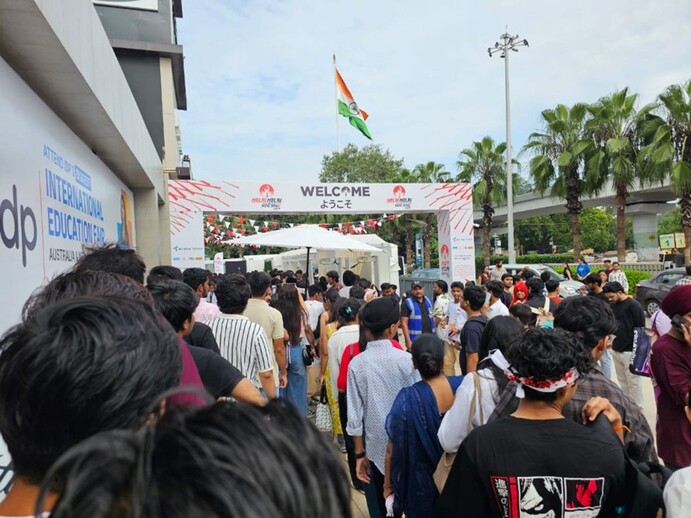
Scene at the venue entrance (The event was held in the plaza of a shopping mall)
The attendees were primarily teens and twenties, with women as noticeable as men. Given India's popularity for anime like NARUTO, Jujutsu Kaisen, and ONE PIECE—all serialized in Weekly Shonen Jump—the author found it surprising to see so many female fans participating. According to my colleague from Intage India, who was at the venue both days, Saturday saw more students and groups of friends, while Sunday drew more families. This event clearly served as a place for young people, regardless of gender, to enjoy themselves with friends and family.
Last year, the event drew about 50,000 people over two days. As of September 25th, the 2025 attendance figures haven't been announced yet. However, it felt like there were even more people this year.
Notably, over 40 Japanese companies and organizations participated, with about half being Japanese IP holders (companies or individuals owning intellectual property). Japanese anime characters and IPs were prominently displayed throughout the venue, drawing large crowds of anime fans to booths and photo spots.
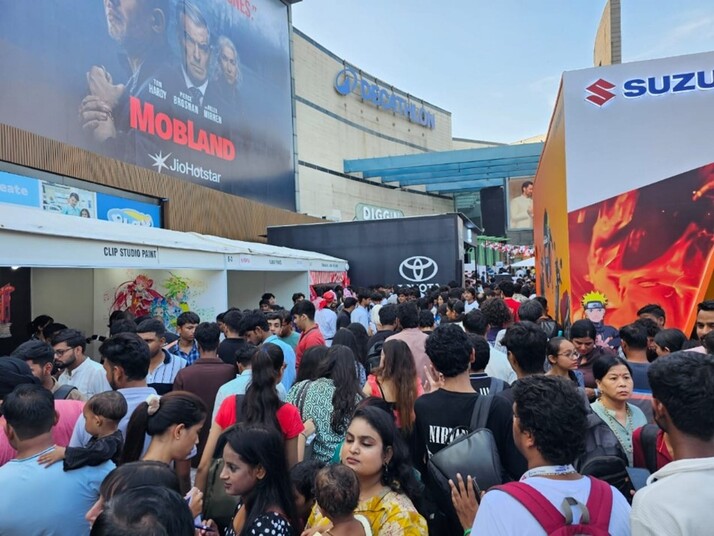
September 14 (Day 2) Around 3:00 PM: Scene at the venue
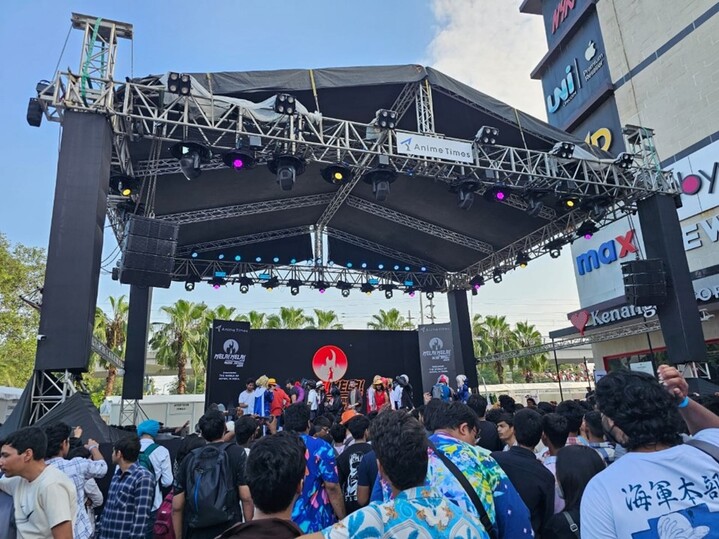
Live performances and cosplay events were held on stage.
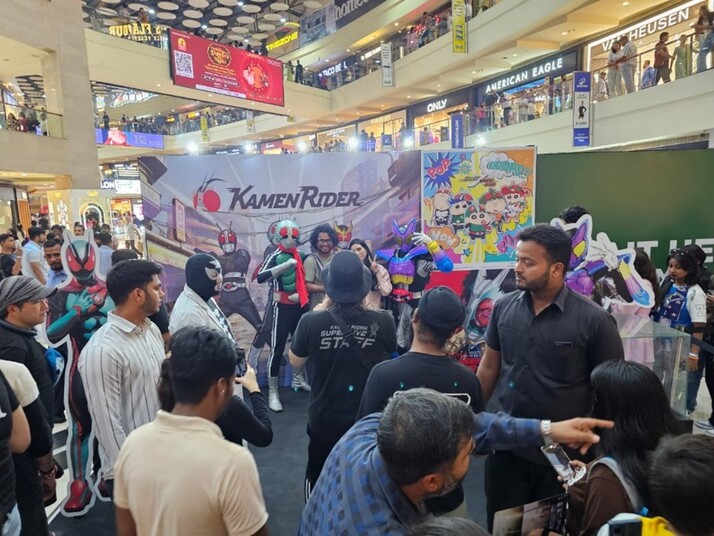
The scene at the photo spot
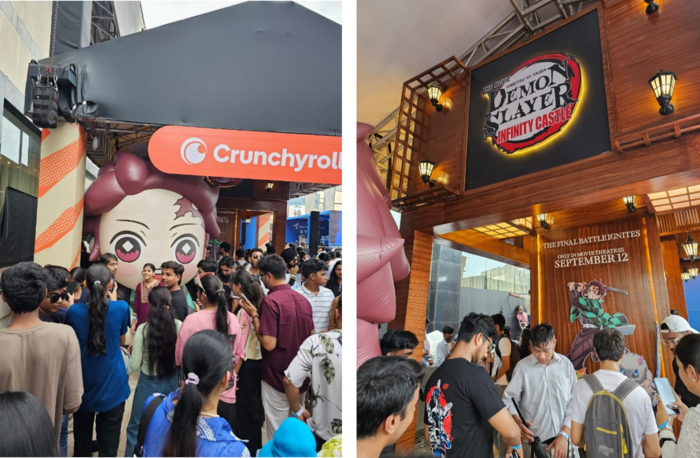
The Crunchyroll booth, inspired by the Infinity Castle from Demon Slayer: Kimetsu no Yaiba
3. Background of Japanese Anime Popularity in India
The biggest factor driving attendance at Japanese events in India, including MMAJ, is undoubtedly the popularity of Japanese anime. The event's official YouTube channel prominently features its anime festival aspect, and a glance at MMAJ-related Instagram posts shows anime content dominates.
“Mela! Mela! Anime Japan!! 2025” 25-sec CM
The popularity of Japanese anime in India has rapidly expanded since the COVID-19 pandemic. Through streaming platforms like Netflix and YouTube, Japanese content has permeated daily life, particularly among teens and young adults in their 20s. When speaking with young people, many cite post-pandemic factors like “it becoming a topic of conversation with friends” or “siblings or relatives watching it” as their reason for starting to watch. In India, where word-of-mouth holds significant influence, trending works tend to spread rapidly.
Indeed, Demon Slayer: Kimetsu no Yaiba - The Infinity Castle Arc, released the day before the event, set a record for the highest advance ticket sales in India for a foreign film outside of Hollywood. Its Hindi-dubbed 4DX screenings reportedly achieved 100% occupancy, with demand far outstripping supply. Considering that the 2020 release “Demon Slayer: Kimetsu no Yaiba - Mugen Train Arc” barely screened in India, this highlights how rapidly Japanese anime's popularity has surged there.
Shows like “Doraemon” and “Crayon Shin-chan,” which aired since the early 2000s, have long been popular with children. However, even before the pandemic, works like ‘NARUTO’ and “DEATH NOTE” were still perceived as “something for kids.” Even when I was assigned to India in 2022, I recall many people still thinking “anime = for children.” In fact, when I interviewed someone from an Indian food company back then, they stated that using anime characters on packaging would only be for children's products.
Now, however, centered around works like Demon Slayer and Jujutsu Kaisen, young people's perceptions are shifting dramatically. I've heard from colleagues that the image of “anime = otaku” no longer exists; anime adaptations of manga (published in Weekly Shonen Jump) are seen as “cool.” The landscape for Japanese anime has changed remarkably: IPs collaborate with companies to sell products, and Japanese anime films are released in theaters almost monthly. There's no doubt that the penetration of Japanese anime among Indian youth has become a major driving force for Japanese culture and event attendance.
4. The Future and Challenges of Japanese Animation
Japanese animation has significant room for further expansion. However, the author believes the key challenges going forward are “language” and “monetization.”
First, regarding language: India has distinct local languages across its regions. Even in urban areas, many people prefer dubbed versions in familiar local languages like Hindi over English subtitles when watching movies. In fact, a friend of mine (a 20-year-old university student) said, “I've watched ‘Crayon Shin-chan’ dubbed in Tamil since I was a kid, so I can only imagine new movies in Tamil.” Just as Japanese people associate “Shin-chan's voice” with a specific actor, it seems characters in India also have firmly established “this voice” associations. Currently, many anime titles not originally broadcast on Indian TV are only available with English subtitles, limiting linguistic access. When considering merchandise and event expansion, it's crucial to strategically determine the target audience and which languages to support.
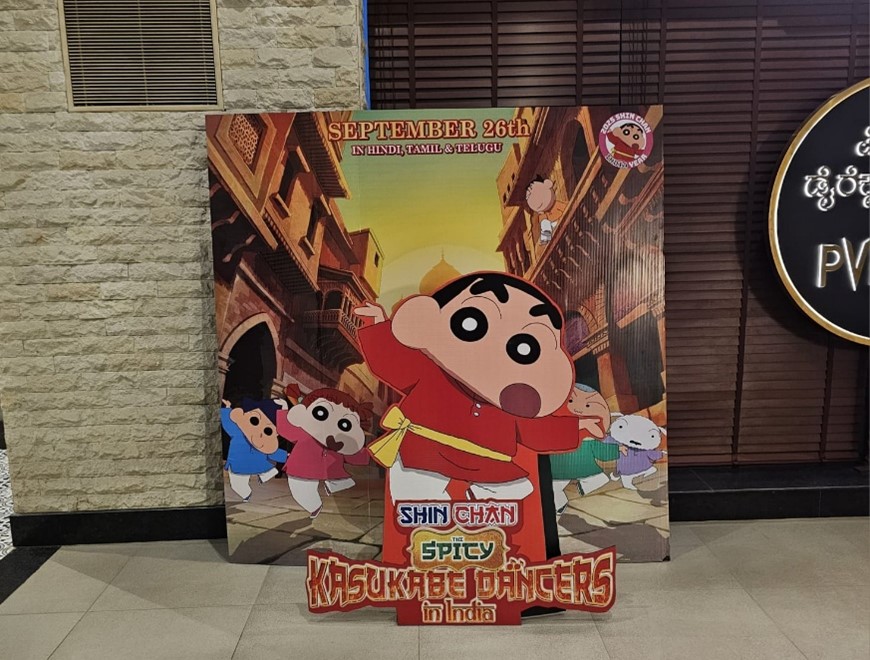
The new Crayon Shin-chan movie, confirmed for release with Hindi, Tamil, and Telugu dubbing
(Photo taken by the author at a Bangalore cinema)
Next is the challenge of monetization. India lacks a deeply rooted manga culture, and imported Japanese manga volumes cost over 1,000 yen each—too expensive for most young people. Consequently, streaming services are the primary gateway to Japanese anime for many, but most rely on free pirated sites or watching through family or relatives' streaming accounts. This has fostered a strong perception that “anime = something you can watch for free.” Many people film theater screenings and post them on social media. The streets are filled with anime goods and T-shirts that are likely not official merchandise, and awareness that anime is copyrighted work is also low.
Unlike Japan's anime culture, which took decades to develop, India's anime scene exploded within a few years. Consequently, normative awareness and business models around anime haven't yet solidified. For companies, identifying effective IP utilization and monetization strategies is crucial. This MMAJ event strictly managed not only the introduction and sale of official IP merchandise but also secondary resale. I believe spreading the cultural awareness and norms cultivated by Japan through such events is highly meaningful.
As a fan of Japanese anime myself, I am delighted to see the growth of Japanese events and anime popularity in India. I firmly believe this market still holds significant potential for growth and business opportunities. Researchers based locally, including myself, aim to continue contributing to the growth of Japanese companies and anime culture through disseminating entertainment information and proposing research initiatives.
〈Source〉
Mela! Mela! Anime Japan!!2025 :
https://mmaj.jp/
Pinkvilla, Demon Slayer Infinity Castle Set to Storm Indian Box Office With Historic Advance:
https://www.pinkvilla.com/entertainment/box-office/demon-slayer-infinity-castle-smashes-advance-booking-records-amazes-with-rs-15-crore-pre-sales-already-1396620
etvbharat, Demon Slayer Infinity Castle Smashes Indian Box Office, Scores A CinemaScore, But Can It Surpass Mugen Train Globally?:
https://www.etvbharat.com/en/!entertainment/infinity-castle-smashes-indian-box-office-scores-a-cinemascore-but-can-it-surpass-mugen-train-globally-enn25091307707
-

Author profile
Kenta Akashio
A Japanese researcher based in Bangalore, India, she started her career in the research industry after teaching elementary school for 7 years. She is mainly in charge of FMCG projects in the food and beverage industry. In order to deepen his understanding of entertainment-related projects, which have been on the rise in recent years, he visits anime and game events in Bangalore as much as possible and aims to participate in all of them.
-

Editor profile
Chew Fong-Tat
A Malaysian who has lived in Japan for 14 years. He is in charge of creating the Global Market Surfer website.
 Global Market Surfer
Global Market Surfer CLP
CLP